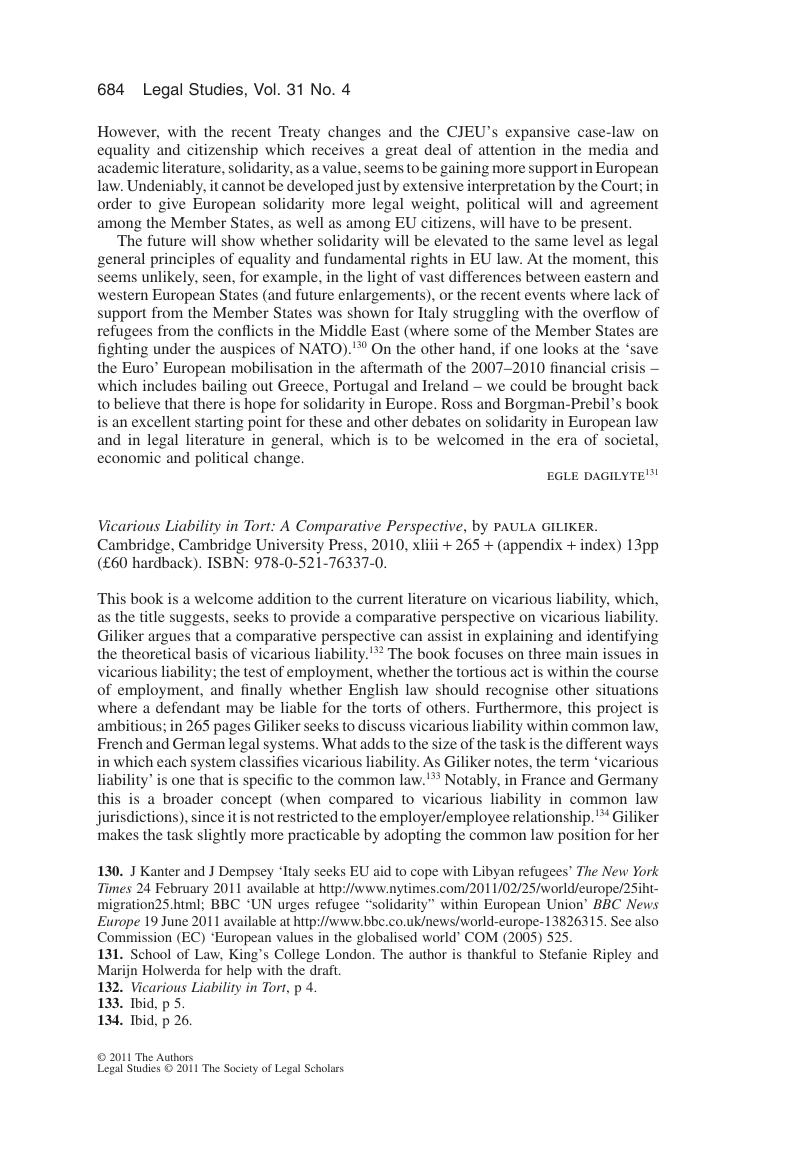No CrossRef data available.
Article contents
Vicarious Liability in Tort: A Comparative Perspective, by Paula Giliker. Cambridge, Cambridge University Press, 2010, xliii + 265 + (appendix + index) 13pp (£60 hardback). ISBN: 978-0-521-76337-0.
Published online by Cambridge University Press: 02 January 2018
Abstract

- Type
- Book Review
- Information
- Copyright
- Copyright © Society of Legal Scholars 2011
References
132 Vicarious Liability in Tort, p 4.
133 Ibid, p 5.
134 Ibid, p 26.
135 Ibid, p 5.
136 Ibid.
137 Ibid, p 6.
138 Penner attributes this analysis to Birks, Peter; Penner, J ‘Resulting trusts and unjust enrichment: three controversies’ in Mitchell, C (ed) Constructive and Resulting Trusts (Oxford: Hart Publishing, 2010) p 238 Google Scholar.
139 [1968] 2 QB 497.
140 (2001) 207 CLR 21.
141 Ibid, p 79.
142 McKendrick, E ‘Vicarious liability and independent contractors – a re-examination’ (1990) 53 MLR 770 CrossRefGoogle Scholar. Giliker does at least identify McKendrick's argument on p 56, but it is only stated that ‘it would, indeed, seem preferable to recognise the distinct needs of each context.’ The same position is adopted in Lunney, M and Oliphant, K Tort Law: Text and Materials (Oxford: Oxford University Press, 2010)Google Scholar where it is identified, p 822, that different policy considerations arise in vicarious liability cases, and that cases from other areas of the law are simply referenced for guidance.
143 [2005] EWCA Civ 1151; [2006] QB 510 at 536 at [77].
144 Vicarious Liability in Tort, pp 66–68, 78.
145 [2009] EWCA Civ 98; [2009] ICR 835.
146 Autoclenz Ltd v Belcher[2011] UKSC 41. The earlier Court of Appeal judgment, which was affirmed by the Supreme Court, was also available when this book was published; [2009] EWCA Civ 1046; [2010] IRLR 70.
147 Giliker also provides the same criticism of proposals for a Europe-wide law on vicarious liability when she states at p 265, that these proposals are ‘problematic in terms of their generality’ and that this means that ‘more guidance is needed’.
148 For example, worker as defined by the Employment Rights Act 1996 s 230(3) is wider than the normal test for employment, encompassing not only employment relationships but also contractual relationships whereby the ‘worker’ undertakes to do work for another who is not a client or customer of any profession or business undertaking carried on by the individual.
149 Admittedly, Lord Steyn in Lister v Hesley Hall[2001] UKHL 22; [2002] 1 AC 215 at [15], thought that the modern approach was rooted in the Salmond approach. Hardiman J in the Irish Supreme Court in O'Keeffe v Hickey[2008] IESC 72; [2009] 2 IR 302 at [109], made the point that the modern authorities bear little resemblance to the original Salmond test.
150 [1999] 2 SCR 534; (1999) 174 DLR (4th) 45.
151 Ibid, at [41–42].
152 [2010] EWCA Civ 256; [2010] 1 WLR 1441.
153 [2003] EWCA Civ 887; [2003] 1 WLR 2158.
154 [1999] 2 SCR 534; (1999) 174 DLR (4th) 45.
155 [1999] 2 SCR 570; (1999) 174 DLR (4th) 71.
156 Vicarious Liability in Tort, p 239.
157 For example, Weinrib, E The Idea of Private Law (Cambridge, Mass: Harvard University Press, 1995) pp 185–187 Google Scholar.
158 Vicarious Liability in Tort, p 19.
159 Holmes, Ow The Common Law (Boston, Little: Brown and Company, 1881) p 289 Google Scholar.
160 See for example, Valcke, C ‘Comparative history and the internal view of French, German, and English private law’ (2006) 19 Can JL & Juris 133 Google Scholar. The difference between common law and civilian systems is often identified as a difference between inductive and deductive reasoning. Inductive reasoning indicates that law is produced from facts, whereas deductive reasoning indicates that law is derived from general principles; see Samuel, G Law of Obligations and Legal Remedies (Abingdon: Cavendish, 2nd edn, 2001) p 13 Google Scholar.
161 Legrand, P ‘against a European civil code’ (1997) 60 MLR 44 at 53–56CrossRefGoogle Scholar.




